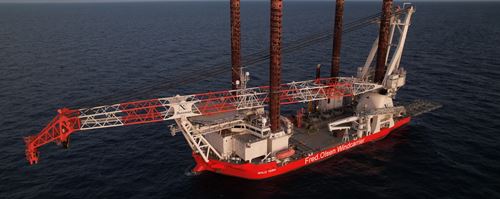Bold Tern just went into service with her new 1600t crane. This means Fred. Olsen Windcarrier will be ready for the largest offshore wind turbines on the market today – as well as those tomorrow. But what are some of the factors involved when installing and operating a new crane of this size, and what makes this one so special?
“There are many challenges when designing and manufacturing a heavy lift crane like this,” says Valentyn Skudra, a senior superintendent with Fred. Olsen Windcarrier who was directly involved in the new crane’s design and commissioning. “It doesn’t simply have to be large enough for today’s next generation turbines, but also for those of tomorrow. You cannot predict exactly how big they are going to get, but with Bold Tern we are perfectly placed to support the industry for many years to come.”
A crane of this size presents many challenges. To accommodate it on board Bold Tern, the existing crane foundation had to be replaced with a custom-made pedestal solution to redistribute the increased load. Additionally, it was necessary for the shipyard to have the correct lifting capacity and height to lift over the leg of the jack-up vessel (92m high!). Only a few places in the world have the capabilities to achieve this.
Furthermore, it was also important to modify the vessel for it to carry larger components. These included hull reinforcements, widening the vessel with sponsons, and deck space upgrades to house the new blades.
Safe operation takes skill and experience
While the crane itself usually gets all the attention, it’s important to give extra credit to the talented people who will be operating it. These skilled individuals are highly experienced in on- and offshore crane operations and all of them hold a Sparrows crane operator stage 3 or G5 license. Nevertheless, manning such a large crane at sea, and moving such large pieces of a wind turbine into place with pinpoint accuracy is no easy task.
“Operating a standard crane is one thing,” says Valentyn. “But lifting large towers, nacelles, and blades with one this big is quite another – it’s a huge responsibility. Not only this, but everything must be done within a tight weather window, and even on the best of days you will still feel some platform movement from the waves and wind.”
There is a significant difference in crane behaviour between a typical offshore crane and this new one. For example, Bold Tern’s crane has up to 1m of horizontal boom deflection, whereas a regular crane would have only 50mm-100mm, which requires a readjustment of the hook position while lifting. Furthermore, moving container vessels on and off a ship can be completed in as little as 5 minutes. Installing a wind turbine can take up to half an hour and requires their absolute concentration and focus. It is a highly co-ordinated operation involving many different teams, including the service personnel who bolt the pieces together.
Bold Tern’s new crane is an incredible piece of engineering
- Valentyn Skudra, Senior Superintendent, Fred. Olsen Windcarrier
Future-proofing the wind industry
Not only is the new crane one of the biggest of its kind, but it is also fully electric. This means that the crane’s response is different to traditional electric/hydraulic systems, which requires a different method to operate. This new electric system is greener and has a lower environmental footprint, which will help both Fred. Olsen Windcarrier and its customers to achieve their sustainability targets.
“Bold Tern’s new crane is an incredible piece of engineering,” concludes Valentyn. “It has been fascinating to watch it come together in the shipyard, but I cannot wait to see it in action. Capable of handling even the largest 15MW turbines, it will also be ready for whatever comes next. I’m proud to be part of a forward-looking industry that is helping to build a better future for us all.”
Read more about Bold Tern here.
